Deborah Swift's Blog
September 22, 2025
Shades of Yellow by Wendy J Dunn #CoffeePotBookClub #Elizabethan #DualTimeline
Shades of Yellow is a dual timeline novel set in the Elizabethan era, featuring the real personages of Amy Robsart and Robert Dudley, Earl of Leicester.
Blurb:During her battle with illness, Lucy Ellis found solace in writing a novel about the mysterious death of Amy Robsart, the first wife of Robert Dudley, the man who came close to marrying Elizabeth I. As Lucy delves into Amy’s story, she also navigates the aftermath of her own experience that brought her close to death and the collapse of her marriage.
After taking leave from her teaching job to complete her novel, Lucy falls ill again. Fearing she will die before she finishes her book, she flees to England to solve the mystery of Amy Robsart’s death.
Can she find the strength to confront her past, forgive the man who broke her heart, and take control of her own destiny?
 REVIEWDual timeline novels sometimes fall into the trap of engaging the reader with one side of the story, and losing them from the other. This novel finds the two timelines seamlessly blended with none of those slightly eggy transitions into the past. Because Lucy is writing a novel, the fictional life of Amy Robsart segues neatly into the story, as Lucy grapples with Lucy’s mysterious death, whilst also realising Amy’s life holds resonance for her own. Being a novelist myself this fictional account of a debut novelist’s obsession with the past really rang bells for me! The book is well-researched and we are treated to Lucy’s excursions to all the places Amy would have known. The mystery of why she died and exactly how, is left to the reader’s imagination, which is as it should be – no glib answers here, the history is honoured yet we are given plenty to think about as readers so that we become as fascinated as Lucy. Lucy’s family, her battle with cancer, and her shifting feelings for her ex keep the plot rolling along nicely.This is a novel written with sensitivity, both to the historical past, and to emotional truth. I thoroughly enjoyed this novel, was gripped throughout, and was sad when it ended. Five stars from me.
REVIEWDual timeline novels sometimes fall into the trap of engaging the reader with one side of the story, and losing them from the other. This novel finds the two timelines seamlessly blended with none of those slightly eggy transitions into the past. Because Lucy is writing a novel, the fictional life of Amy Robsart segues neatly into the story, as Lucy grapples with Lucy’s mysterious death, whilst also realising Amy’s life holds resonance for her own. Being a novelist myself this fictional account of a debut novelist’s obsession with the past really rang bells for me! The book is well-researched and we are treated to Lucy’s excursions to all the places Amy would have known. The mystery of why she died and exactly how, is left to the reader’s imagination, which is as it should be – no glib answers here, the history is honoured yet we are given plenty to think about as readers so that we become as fascinated as Lucy. Lucy’s family, her battle with cancer, and her shifting feelings for her ex keep the plot rolling along nicely.This is a novel written with sensitivity, both to the historical past, and to emotional truth. I thoroughly enjoyed this novel, was gripped throughout, and was sad when it ended. Five stars from me. Praise for Shades of Yellow:“Shifting between 2010 and the Elizabethan era, Wendy J. Dunn’s compelling new novel Shades of Yellow explores the complexities of relationships, creative ambition, and medical pain through the eyes of two brave women living centuries apart. Forced to confront the decisions that have brought them to their respective crisis points, Lucy and Amy seek to rewrite their own destinies. A treat for lovers of history and strong stories.“~ Lauren Chater, author of The BeautiesBUY THE BOOK This title is available to read on #KindleUnlimited.
Praise for Shades of Yellow:“Shifting between 2010 and the Elizabethan era, Wendy J. Dunn’s compelling new novel Shades of Yellow explores the complexities of relationships, creative ambition, and medical pain through the eyes of two brave women living centuries apart. Forced to confront the decisions that have brought them to their respective crisis points, Lucy and Amy seek to rewrite their own destinies. A treat for lovers of history and strong stories.“~ Lauren Chater, author of The BeautiesBUY THE BOOK This title is available to read on #KindleUnlimited.
 Wendy J. Dunn is a multi-award-winning Australian writer fascinated by Tudor history – so much so she was not surprised to discover a family connection to the Tudors, not long after the publication of Dear Heart, How Like You This, her first Anne Boleyn novel, which narrated the Anne Boleyn story through the eyes of Sir Thomas Wyatt, the elder.Her family tree reveals the intriguing fact that one of her ancestral families – possibly over three generations – had purchased land from both the Boleyn and Wyatt families to build up their holdings. It seems very likely Wendy’s ancestors knew the Wyatts and Boleyns personally.Wendy gained her PhD in 2014 and tutors in writing at Swinburne University of Technology, Australia. She loves walking in the footsteps of the historical people she gives voice to in her books.Connect with Wendy:Website: http://www.wendyjdunn.com/ Facebook: https://www.facebook.com/authorwendyjdunn Instagram: wendyjdunnauthor
Wendy J. Dunn is a multi-award-winning Australian writer fascinated by Tudor history – so much so she was not surprised to discover a family connection to the Tudors, not long after the publication of Dear Heart, How Like You This, her first Anne Boleyn novel, which narrated the Anne Boleyn story through the eyes of Sir Thomas Wyatt, the elder.Her family tree reveals the intriguing fact that one of her ancestral families – possibly over three generations – had purchased land from both the Boleyn and Wyatt families to build up their holdings. It seems very likely Wendy’s ancestors knew the Wyatts and Boleyns personally.Wendy gained her PhD in 2014 and tutors in writing at Swinburne University of Technology, Australia. She loves walking in the footsteps of the historical people she gives voice to in her books.Connect with Wendy:Website: http://www.wendyjdunn.com/ Facebook: https://www.facebook.com/authorwendyjdunn Instagram: wendyjdunnauthorTikTok: https://www.tiktok.com/@wendyjdunn Amazon Author PageThe post Shades of Yellow by Wendy J Dunn #CoffeePotBookClub #Elizabethan #DualTimeline first appeared on Deborah Swift.
September 18, 2025
Deborah Swift talks to Amy Maroney about Operation Tulip, her WW2 novel of Dutch Resistance
Here’s an interview I did with historical novelist Amy Maroney, reproduced here from her lovely website
What inspired you to write about that particular era or character?
I have already written a number of books set in WW2 – in fact this will be my sixth. I was fascinated by the fact that parts of Holland remained under Nazi occupation after the rest of the country had been freed, and I began researching what might have happened to the Dutch population during the so-called ‘Hunger winter’. During this time because the country was cut off from supplies, the Resistance networks began to crumble and it became more difficult to feel any sense of hope. I wanted to write about what it would be like to be under such pressure.
How did you create a realistic setting for your story?
I read many memoirs of people who lived through this period in Holland and I have visited The Hague where the book is set. I also did a lot of internet research for maps and for photographs taken at the time. Some of the photographs of the starving population are quite harrowing, but the photographs bring home the reality of the situation and what it was like for the thousands of Dutch in the Northern occupied cities.
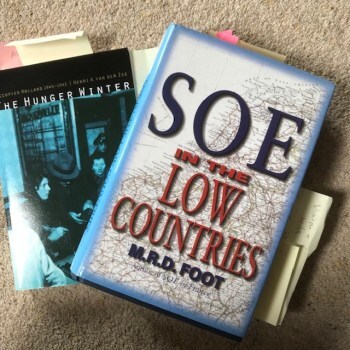
Do your research findings guide the plot, or do you plan out the plot first and flesh it out with research? (Or perhaps both?)
I write without any outline, just a one page idea of where the plot might go. The research then supplies me with other ideas and I try to integrate these as I go along, using the real characters and events if possible, alongside my fictional characters. Because the research drives the plot I don’t have a fixed idea at the outset but let the plot come out of what I discover. This means I sometimes have to do a lot of re-writing, but it also keeps me engaged and interested right to the end.
Name three historical facts or events that helped bring your main character to life.
My character is based on real life heroines of the SOE – agents that were dropped into occupied countries. I was inspired by the radio operators and couriers whose lives are quite well-documented. Also Dutch Resistance fighters such as Hannie Schaft and Truus and Freddie Oversteegen, who took great risks to discover intelligence useful to the Allied cause. The novel is set in and around The Oranjehotel which was the prison used by the Nazis to house Resistance prisoners. There is a museum there now which tells its story, and this was one of the linchpins of the plot. In the novel I also make use of the humanitatian aid drops, Operation Manna and Operation ChowHund. These were food drops by British and American planes and saved many lives at a time of desperate need.
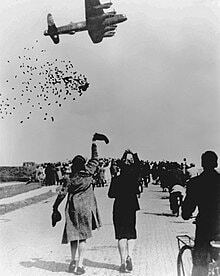
Do you completely plan out your cast of characters before writing, or do you sometimes add new characters as you go along?
As I don’t plan, characters do pop up whenever I think they are needed. I usually have one or two main characters, and the rest seem to just appear when they feel like it! In this book, the character of Steef, Nancy’s main contact for the Resistance arrived in exactly that way, and he was a very useful man for driving the plot. Of course later he meets a sad end, none of which I’d planned beforehand. What became apparent when I was writing the book was that the Resistance in Holland was always in flux because many agents did not survive for long. There were many collaborators with the Nazis on Dutch soil, and allegiances could switch at the drop of a hat. I wanted to portray this, and so there are more characters in this novel than in many of my others.
Do you have any tips for other writers about keeping track of your historical fiction research?
I keep track of it as I go along through notebooks and through annotations to the text by using the comments box. I always save a copy of the annotated version before sending the clean version to my agent and editor.
What do you have planned for your next writing project?
I am editing a new book at the moment – Last Train to Freedom. It is set in Russia on the Trans-Siberian express. That is set in the 20th Century, but I do also love to write about earlier periods and have a fourth book in the Poison Keeper Series on the go too. I like to mix periods to keep myself interested, and so I don’t get stale, and I’m currently working on a novel set in Shanghai.
Last Train to Freedom is already out – and The Enemy’s Wife, set in Shanghai, will publish soon.
Thank you to Amy Maroney, check out Amy’s books here and het her free story.
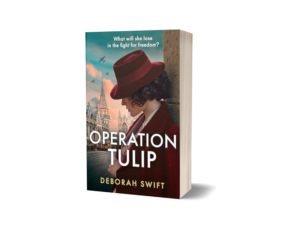
Tailored Truths by Nancy Jardine @Nansjar #CoffeePotBookClub
A signal bell from the orchestra below, and the dimming of the gas lights that bordered the stage, heralded a noisy return of those who had left their seats. For a minute or two, it seemed to Margaret that the people who had been chatting were rushing their conversations to conclude them before the Second Act began. The buzz of expectancy around the auditorium was quite a palpable delight.
Margaret decided that attending a theatre performance truly was a brand new and tremendously exciting experience and being clad almost as beautifully as the women around her was a thrill in itself.
The second and third acts made more sense and Margaret found she was thoroughly enjoying the opera. They had had some refreshments during the longer second interval so when the shorter third one came, she expected a continuation of their dissection of the opera. She was quite unprepared for the corridor door to the box being rapped upon before it opened, obscuring her in behind it.
“Forgive my intrusion. I noticed your party and came across to pay my respects.”
Margaret gulped. The voice was definitely familiar. She didn’t need to lean forwards to know that it was the Earl of Sefton who stepped in past her to greet the others before he closed the door behind him.
The conversation which followed made clear that the Earl of Sefton had already met Mister and Mistress Grainger. The performance was briefly commented upon before the earl made to take his leave again after the signal for the end of the short interval rang clear and the gas lighting was dimmed.
Margaret opened the corridor door, shifting back a little to allow him more space to exit. She found that she was then the recipient of his attention, his focus on her alone. The expression in his gaze was akin to admiration but it veiled something else, something more expectant. His words were a whisper since the auditorium had quietened down, expectantly awaiting the orchestra to resume.
“You are looking particularly fetching tonight, Miss Law.”
Margaret stared at him, hoping her swallow wasn’t heard by the others, the flustering inside her not something she wanted to happen. How was she supposed to respond to a comment like that? Coming from an earl?
The almost smile that she’d detected on his face slipped away when he realised she wasn’t gushing her thanks, and wasn’t saying anything at all.
“But I digress. The school that I mentioned the other day?”
Margaret managed a brief nod. “My Lord, I do remember.”
“You may be pleased to know that my architect and I finally agreed on the last of the plans, yesterday. Building work will begin very soon.” There was a momentary pause before he continued, the intensity of his eyes illuminated by the nearest corridor lamplight. “I wondered if you would be interested in seeing the plans the day after tomorrow, when I have some free afternoon time, Miss Law? A fresh eye from one who has knowledge of the pupil being taught has to be a good thing at this stage.”
Disappointment warred with quite a degree of embarrassment at his words, but more from the renewed speculation in his expression. It took no more than an instant to decide to appear obtuse about any possible inference that he wasn’t just going to show plans to her.
“Oh, I would have loved to look at the architect’s drawings, My Lord,” she said. “I’d be very interested in seeing them, but unfortunately I won’t be here. Miss Marianne is returning to Dundee tomorrow.”
“Ah, in that case I will bid you goodbye, Miss Law.”
The door shut silently behind him leaving Margaret quite perplexed. His slight aloofness was much as it had been at Croxteth Hall, but as Marianne had mentioned days before there was more than a hint of something in the earl’s eyes that indicated an anticipation – about more than his building project.
An eagerness about anything more personal would have been a disaster, Margaret was sure of that. He was definitely a tempting morsel, a handsome man indeed who just might have been considering an illicit liaison with someone like her. Though perhaps she had just been reading him completely wrongly and it was just because he had made her pulse increase.
She was thankful that Marianne had heard none of the conversation as she slipped down onto her seat, the music restarting and the stage curtain fluttering upwards. She willed the twitching inside her stomach to settle down.
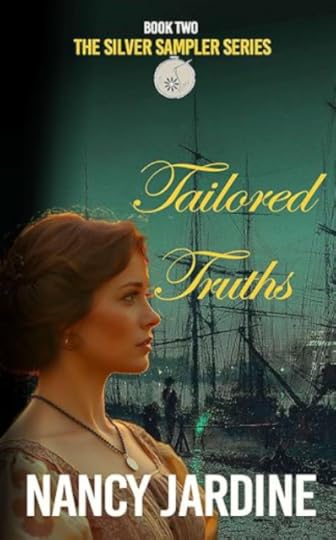
Is self-supporting success enough for Margaret Law or will her future also include an adoring husband and children? She might secretly yearn for that though how can she avoid a repeat of relationship deceptions that disenchanted her so much during her teenage years?
Employment as a lady’s maid and then as a private tutor in Liverpool in the 1860s bring thrilling opportunities Margaret could never have envisaged. Though when those posts end, her educational aspirations must be shelved again. Reliance on her sewing skills is paramount for survival when she returns to Dundee.
Meeting Sandy Watson means love, marriage and starting a family – though not necessarily in that order – are a striking development though it entails a move north to Peterhead. Yet, how can Margaret shed her fear of commitment and her independence and take the plunge?
Jessie, her sister-at-heart, is settled in Glasgow. Frequent letters are a life-line between them but when it all goes horribly wrong the contents of Margaret’s correspondence don’t necessarily mirror her awful day-to-day realities.
#KindleUnlimited.
 About Nancy Jardine
About Nancy Jardine

Nancy Jardine writes historical adventure fiction, historical saga, time travel historical adventure and contemporary mysteries.
Research, grandchildren, gardening fill up her day in the castle country of Aberdeenshire, Scotland, when not writing or promoting her writing. Interacting with readers is a joy at Book and Craft Fairs where she signs / sells paperback versions of her novels. She enjoys giving author presentations on her books and on Ancient Roman Scotland.
Memberships include: Historical Novel Society, Scottish Association of Writers, Federation of Writers Scotland, Romantic Novelists’ Association, and the Alliance of Independent Authors.
She is self-published with Ocelot Press.
Find Nancy:
Website • Facebook • Bluesky • Instagram • Twitter / XAmazon Author Page • Pinterest • BookBub • LinkedIn • GoodreadsThe post Tailored Truths by Nancy Jardine @Nansjar #CoffeePotBookClub first appeared on Deborah Swift.September 8, 2025
Astrology and Medicine in the Renaissance #BlogPost #GiuliaTofana
The third book in my Italian Renaissance series, The Fortune Keeper, begins the story of Girolama Spera, Giulia Tofana’s daughter, and a real historical person who was also accused of poisoning a generation of men, by following in her mother’s footsteps.
She was known as ‘The Astrologer’ – hence the title of the book. At the beginning of the book, Girolama (nicknamed in my book Mia, to avoid confusion with her mother, Giulia) is embarking on her study of astrology with Bravaggio, an astrologer who is much influenced by the work of Galileo.
Astrology in the time of Galileo
‘Astrology in seventeenth century England was not a science. It was not a Religion. It was not magic. Nor was it astronomy, mathematics, puritanism, Neo-Platonism, psychology, meteorology, alchemy or witchcraft. It used some of these as tools; it held tenets in common with others; and some people were adept at several of these skills. But in the final analysis it was only itself: a unique divinatory and prognostic art embodying centuries of accreted methodology and tradition’ – Science Historian Ann Geneva
This statement was as true for Renaissance Italy as it was for England. Astrologers of the Italian nobility, for example Ficino and his patrons the Medicis, would use horoscopes to determine the fate and future of people, events and new projects. Men we regard as bastions of science now, such Kepler or Galileo, were actually practicing astrologers at this time.
Astrology has always been blurred with astronomy, with the search for human meaning in the sky; the desire to look to the stars and planets for answers to the mysteries of human life. In medieval Europe astrology was used in the universities in the seven so-called liberal arts which were each allied to a planet. The arts of astrology and astronomy, which were largely conflated together, were assigned to Saturn.
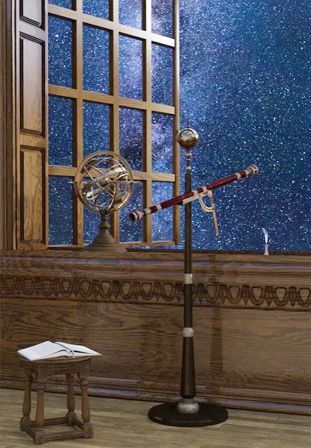
In the 17th Century the invention of the telescope (formerly known as a spy-glass) changed the world view and completely undermined one of the purposes of astronomy – the casting of horoscopes. The idea of the horoscope relied on the belief in a fixed Earth which was always to be central in the Christian view of Creation. The lens of the telescope revealed the vastness of space and that there were infinite stars and planets invisible to the naked eye.
In January 1610, Galileo made a startling discovery using one of the new telescopes. He was able to observe the moons orbiting Jupiter. His subsequent book, Siderius Nuncius (Starry Messenger) which describes this, rejected the old Earth-centred idea of the universe, and also the long-held doctrines of the Catholic Church. Galileo became a cultural martyr to this new cause, that of the earth in movement around the sun, and his ideas were condemned as heresy by the Catholic Inquisition.
In June 1633, He was declared guilty of and made to recite and sign a formal confession:
‘I curse and detest the said errors and heresies, and generally all and every error, heresy, and sect contrary to the Holy Catholic Church.’
Tradition, but not historical fact, holds that, after abjuring, Galileo mumbled the contradictory opinion; ‘Eppur si muove’ (And yet still it moves).
Astrology for Dog Bites and Broken Hearts
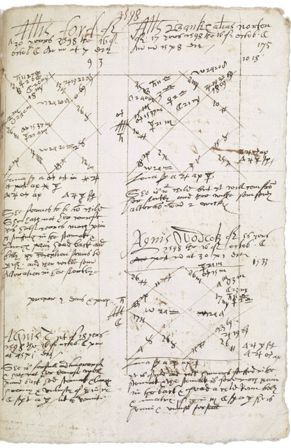 A page from Simon Forman’s casebook
A page from Simon Forman’s casebookfor 16 October 1598. MS Ashmole 195, f. 175r.
Copyright Bodleian Library, University of Oxford, 2018.
Two physicians of 17th-Century England left behind an expansive archive of 80,000 patient records which were gathered together in 66 calf-bound volumes. Volumes such as this must also have been common in Italy, where astrology was taught as part of the medical training of physicians at the University of Padua.
‘thousands of pages of cryptic scrawl full of astral symbols, recipes for strange elixirs, and details from the lives of lords and cooks maids suffering with everything from dog bites to broken hearts,’
(Professor Lauren Kassell from Cambridge’s History and Philosophy of Science department.)
A team of researchers from Cambridge University have now finished the fascinating task of sifting through these scribbled notes and astrological diagrams to digitize their findings, and they are now housed in a library known as The Casebooks Project.
Such was the acceptance of astrology in this era that Ficino, when asked for advice by the King of Hungary in 1489, recommended entrusting his health to doctors and astrologers who study the stars for cures since this is ‘science and common sense’.
Astrology on your Hat
Here is the beautiful Arundel Jewel, which, though made in 16th Century for the Duke of Mantua, shows the Zodiac just as we know it today. It is believed that this rare and precious jewel was once worn as a hat ornament, and not as a simple pendant as seen here. I can’t imagine wearing something so precious where it might get lost or easily stolen by someone grabbing your hat!
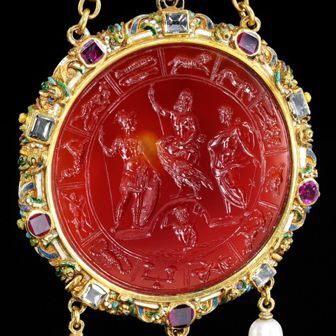
The Arundel Zodiac is a rare 16th-century intaglio carved with Jupiter astride an eagle, flanked by Mars and Mercury, and Neptune underneath. The composition is encircled by a frieze with the signs of the Zodiac. Only three such Zodiac gems exist from the period – one in the State Hermitage Museum, St Petersburg, one in the French royal collection; and this one. On the back of this gem is a stunning depiction of a crane set amongst exotic flowers. The vibrantly enamelled crane likely serves as a representation of the spirit rising from the terrestrial world
Astrological beliefs were not exclusive to the educated and the rich upper classes, but through the culture of Renaissance Italy reached right down to the lower levels of society. The astronomer Bartolomeo on completion of the astrological clock tower in the Piazza Erbe, Mantua, said that it not only told people the time but also ‘the critical days in which infirmities are possible.’ If you’d like to know more, here is a short but stunning video from Sotheby’s about the jewel.
READ MORE:
Sources for The Casebook Project: Lauren Kassell, Michael Hawkins, Robert Ralley, John Young, Joanne Edge, Janet Yvonne Martin-Portugues, and Natalie Kaoukji (eds.), ‘Casebooks’, The casebooks of Simon Forman and Richard Napier, 1596–1634: a digital edition, https://casebooks.lib.cam.ac.uk
This title is available to read on #KindleUnlimited.
Universal Link: https://mybook.to/FortuneKeeper
Audiobook Buy Links:
Kobo: https://www.kobo.com/gb/en/audiobook/fortune-keeper-the
Audio: https://www.audible.co.uk/pd/The-Fortune-Keeper-Audiobook/B0C63R95WM
New Release! The Stars Over Rome by Charlotte Betts #Historical #Romance #Italy
I’m thrilled to highlight Charlotte Betts’ new release The Stars Over Rome. I’ve read all of Charlotte’s books and they never disappoint with their combination of excellent research, lush settings and romantic appeal.
Here’s the blurb:
In a world where women are often overlooked, can Gabriella defy expectations and carve out a place for herself in a rapidly changing society?
Rome, 1913
To her mother’s dismay, Gabriella Hazelwood has no interest in marriage or a quiet domestic life – not when she has big dreams of becoming a journalist. But when she meets Marco Santorelli, a handsome newspaper heir who believes in her ambitions as much as she does, Gabriella begins to wonder if she can have both a husband and a career.
Under the magical stars of Rome, their connection deepens, and a sweeping love story begins . . . until the shadow of war casts a dark cloud over Europe.
When Marco is called to the front, and his family’s newspaper teeters on the brink of collapse, Gabriella steps in to help, only to face fierce resistance from those who believe a woman has no place in the newsroom. As she fights to prove herself, tradition and progress collide, loyalties are tested, and the devastating consequences of war jeopardises all that she holds close to her heart.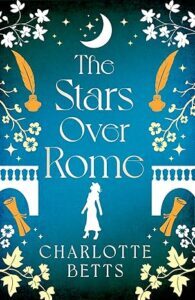 Why do readers love Charlotte Betts?
Why do readers love Charlotte Betts?
‘Lush, romantic and full of intrigue‘ Tracy Rees, Richard & Judy bestselling author
‘A deeply romantic novel whose vivid characters will linger in your mind‘ Margaret Kaine
‘A stunning and captivating read . . . full of drama, love, loss and life’ Book Literati
‘Lingers in the heart long after the final page is turned . . . a must read for anyone who wants to be absorbed as well as utterly enchanted‘ Carol McGrath
‘A compelling story, beautifully written and brought alive with rich historical detail‘ Liz Harris
BUY THE BOOK UKAbout Charlotte:
 Charlotte Betts began her working life as a fashion designer in London. A career followed in interior design, property management and lettings.
Charlotte Betts began her working life as a fashion designer in London. A career followed in interior design, property management and lettings.
Always a bookworm, Charlotte discovered her passion for writing after her three children and two step-children had grown up. Her debut novel The Apothecary’s Daughter won the YouWriteOn Book of the Year, the Romantic Novelists’ Association , the Joan Hessayon Award for New Writers and the RoNA’s Historical Category award, and she has gone on to win many more awards for her subsequent novels which have been translated into eight different languages.
You can find Charlotte online here:
www.charlottebetts.co.uk Twitter: @CharlotteBetts1 Facebook: Charlotte Betts – Author Instagram: charlottebetts.author
The post New Release! The Stars Over Rome by Charlotte Betts #Historical #Romance #Italy first appeared on Deborah Swift.August 7, 2025
Cairo Gambit by SW Perry #ARC #Review #Egypt
‘An enthralling thriller … hypnotically readable’ ANDREW TAYLOR
In the heat of the desert, will the trail go cold?
Cairo, 1938
Archie Nevenden is many things: amateur archaeologist; theatre impresario; absent father; potential defector. And now, he’s a missing person.
His daughter, Prim, hasn’t seen him for nearly fifteen years. But she’s never given up on him, and now she’s on her way to Cairo to assist in the search.
Harry Taverner claims to work for the British Council, but Prim knows there’s more to it. He clearly has a theory about what happened to Archie, one she’s not going to like.
As Prim and Harry uncover the layers of Archie’s existence in Cairo, they find themselves drawn in to more than one conspiracy. And soon they’ll discover that Archie may not be the only one in danger…
Praise for S W Perry:
‘Powerful, panoramic’ Sunday Times
‘Beautifully written, entirely convincing’ Leonora Nattrass
‘Gripping and heartfelt’ Elisabeth Gifford
‘Sweeping’ Daily Mail
July 28, 2025
Marguerite by Judith Arnopp #CoffeePotBookClub #QueenofEngland
I’m a big fan of Judith Arnopp’s books, so I’m delighted to host this excerpt from Marguerite! Hell Hath No Fury.
1443 – Having produced an heir for England, Marguerite returns to court, hoping for a warm welcome.
After an uneasy Christmas season, the new year sees the divisions at court widening and deepening. I am convinced the great fissure has grown so wide that it will never now be healed. The uneasy friendship that once existed has inflated into the blackest enmity. York is like a great chained beast that, once unleashed, will tear me to pieces. I am the Frenchwoman, the whore, and he has even begun a rumour that Prince Edward is not the king’s son. It is an easy lie to believe; one look at Henry is enough to convince any man the king is not capable of begetting a child, let alone a son.
As the day of the council meeting approaches, I prepare myself. I stand at my window and watch as the dawn slowly reveals a white sky; cold, yet showing no threat of rain or worse. I have them dress me in my finest, most regal robes, and enter the meeting to discover proceedings have already begun without me. A gentleman speaking halts mid-sentence when I enter, and all heads turn toward me. Heedless of my interruption, I take a seat hastily vacated by Warwick at the head of the table.
“Gentlemen. My apologies for my late arrival. I see my absence hasn’t delayed you.”
They bow and wait for my permission to be seated. I keep them standing for as long as I can before reluctantly indicating they may sit.
“Gentlemen,” I repeat, endowing them with a brittle smile. “My advisor and I have prepared a list of five articles for the immediate future. The king is still not completely well, his illness is lasting longer than we had hoped, but the royal physicians assure me he is showing great signs of improvement. Therefore, for a short time, the governing of the country can be safely undertaken by myself and the gentlemen listed in this document.”
York stands up, opens his mouth to interrupt, but I continue to speak, raising my voice a little, determined to make my point. In truth, several of my former supporters are uneasy; not at my ability to rule in Henry’s stead, but at the obvious effect such a move will have on the atmosphere at court, where enmities increase daily, forcing men to take sides. No man should be required to choose between the Queen and the Duke of York, whose lust for power knows no bounds. But it is York who should withdraw, not I.
In more civilised countries, the solution would be obvious. There is nobody better suited to protect the well-being of my husband and son than myself, the queen. York, however, does not agree. As soon as he can make himself heard, he snarls his dissention.
“That is ludicrous. No man in England will feel safe under the rule of a woman. As the king’s heir, it is clearly my duty…”
“But you are no longer his heir,” I interject coolly. “My son, the Prince Edward, is now heir, and I am perfectly equipped for the role of regent. My own mother ran my father’s affairs for many years …”
“The affairs of a duchy! This is England, we do things properly here. There is not a man present who will agree to such a thing.”
I swallow my fear that he might be right. He will know that my allies, given the opportunity, will completely oust him from power. I school my expression to one of supreme confidence.
“You have not even glanced at the document, my lord. Perhaps you should do so and then we can continue with the day’s business.”
He snatches the parchment from the table and scowls at it, smacks it with the back of his fingers.
“This is preposterous nonsense. She demands the rule of the country, the right to appoint all officers of the realm, including the bishoprics! As you can imagine, that would leave many of us kicking our heels in the country while she turns England into another territory of France.”
I lean forward with my brows lowered.
“I would do no such thing. I am the Queen of England; the realm, the king and his heir are of supreme importance to me. I have no loyalty to France.”
He tosses the carefully drawn paper onto the table.
“I don’t know why you took the time and trouble to have such nonsense set to parchment. There are few here who will vote in your favour. Your role as queen I will grant you, but that role requires nothing more than the production of heirs. I suggest you see if you can rouse the king enough to give you one, if indeed it was he who sired your son.”
A gasp runs around the gathering. Even I am taken aback. Buckingham stands up.
“You speak treason, York, and defame your king! I demand an apology.”
I turn my head slowly toward Buckingham; it has not escaped my notice that he speaks out in defence of the king’s virility, but fails to defend my virtue. But York, knowing he has overstepped the mark, backs down.
“Forgive me, Gentlemen, I was too hot. I beg pardon.”
Again, I do not miss that he has omitted me from his apology.
“I suppose we must take a vote on it though,” he says. He reads slowly through the list of articles, his bored voice making no secret of how he expects his adherents to vote. “Those who are for, raise your hands.”
A few hands wave in the air; those I expected to cast in my favour.
“Those against?”
A bristling of fingers, as aggressive as spears, puts an end to my aspirations as Protector. Sickness washes over me, hatred and frustration that lies in my belly as bitter as poison. Without speaking, I stand up and quit the company and, as I hurry away, the sound of their derision follows me, the cruel masculine ridicule for a woman who has attempted to step from her allotted place.
God damn them all.
Marguerite: Queen of EnglandFrom the moment Henry VI’s new queen, Marguerite of Anjou, sets foot on English soil she is despised by the English as a foreigner, and blamed for the failures of the hundred years war in France. Her enemies impede her role as the king’s consort and when Henry sinks into apparent madness, her bid to become regent is rejected. Marguerite must fight, not only for her own position but to maintain Henry’s possession of the crown.The ambitious Duke, Richard of York, seizes control of the country, thrusting Marguerite aside and inflating the mutual hatred between the houses of York and Lancaster. But the queen refuses to relinquish power and fights determinedly for the rights of her son, Edward of Lancaster.The long and bitter civil conflict, that has come to be known as the War of the Roses, commences.
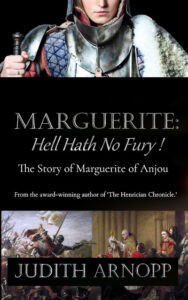
July 20, 2025
A Mischief of Murder by Helen Hollick #CosyMystery #CoffeePotBookClub
Today, I’m delighted to host A Mischief of Murder by Helen Hollick.
About the BookA Mischief of Murder is the sixth Jan Christopher Cosy Mystery
The village Flower and Veg Show should be a fun annual event – but who added mischief and murder to the traditional schedule?

Old friends and new enemies? Jan Christopher’s Aunt Madge is to be a judge at Chappletawton’s annual village flower and vegetable summer show – a chance for the family to have a holiday in the Devon countryside, especially as Jan’s fiancé, DS Laurie Walker, is still recovering from gunshot wounds and her uncle, DCI Toby Christopher, is enduring injury-related sick leave.
The event should be a fun occasion where friendly rivalry between gardeners, cooks and crafters leads to the hopeful winning of the coveted Best In Show trophy – but who added mischief and murder to the traditional schedule?
Praise for the Jan Christopher Mysteries:
“A delight—Miss Read meets The Darling Buds of May, with a dash of St. Mary Mead. Helen Hollick’s signature voice shines throughout, full of warmth and wit. The characters keep growing in such satisfying ways, making every visit feel like coming home.”
Elizabeth St.John
“The Darling Buds of May …but in Devon instead of Kent.”
Alison Morton
“I sank into this gentle cosy mystery story with the same enthusiasm and relish as I approach a hot bubble bath, and really enjoyed getting to know the central character, a shy young librarian, and the young police officer who becomes her romantic interest. The nostalgic setting of the 1970s was balm, so clearly evoked, and although there is a murder at the heart of the story, it was an enjoyable comfort read.”
Debbie Young, author of the Sophie Sayers cosy mysteries
“A delightful read about a murder told from the viewpoint of a young library assistant. The author draws on her own experience to weave an intriguing tale.”
Richard Ashen – South Chingford Community Library
“I really identified with Jan – the love of stories from an early age, and the careers advice – the same reaction I got – no one thought being a writer was something a working-class girl did! The character descriptions are wonderfully done.”
Buy Links
https://mybook.to/MischiefOfMurder
This title is available to read on #KindleUnlimited.
Excerpt from A Mischief of Murder
Snippet 1:
Beyond illustrations and photographs in books, I had no recollection of ever seeing the incredible Neolithic monument of Stonehenge, although as we parked the car and walked across the expanse of grass towards the huge standing stones, Aunt Madge informed me that I had been here before.
She elaborated as she fished her camera from its leather carry case, and inspected the lens settings. “You were only just two years old. We were a merry party, you, your twin sister June, your mother and me.” She started snapping photos of the stones as she spoke. “I’d offered to drive down to the wedding. Mind, it was February and bitter cold. Even the underwear your mother had knitted didn’t do much for the ice chills whipping up our skirts.” She laughed as she took another photograph. “My goodness, but the woolly knickers and vest itched! I recall my skin was red raw by the time we reached our hotel. I dropped the darn things straight into the bin, I can tell you!”
About the Author
Known for her captivating storytelling and rich attention to historical detail, Helen’s historical fiction, nautical adventure series, cosy mysteries – and her short stories – skilfully invite readers to step into worlds where the boundaries between fact and fiction blend together.

Helen started writing as a teenager, but after discovering a passion for history, was initially published in 1993 in the UK with her Arthurian Pendragon’s Banner Trilogy and two Anglo-Saxon novels about the events that led to the 1066 Battle of Hastings, one of which, The Forever Queen (USA title – A Hollow Crown in the UK) became a USA Today best-seller. Her Sea Witch Voyages are nautical-based adventures inspired by the Golden Age of Piracy. She also writes the Jan Christopher cosy mystery series set during the 1970s, and based around her, sometimes hilarious, years of working as a North London library assistant. Her 2025 release is Ghost Encounters, a book about the ghosts of North Devon – even if you don’t believe in ghosts you might enjoy the snippets of interesting history and the many location photographs.
Helen and her family moved from London to Devon after a Lottery win on the opening night of the London Olympics, 2012. She spends her time glowering at the overgrown garden, fending off the geese, chasing the peacocks away from her roses, helping with the horses and wishing the friendly, resident ghosts would occasionally help with the housework…
Other recent releases:
FATE Tales of History, Mystery and Magic –
an anthology of short stories by various award-winning authors
GHOST ENCOUNTERS: The Lingering Spirits of North Devon
LinksWebsite: https://helenhollick.net/
Amazon Author Page: https://viewauthor.at/HelenHollick
Facebook: https://www.facebook.com/helen.hollick
Twitter: https://twitter.com/HelenHollick
Bluesky: @helenhollick.bsky.social
Blog: supporting authors & their books: https://ofhistoryandkings.blogspot.com/
Monthly ‘newsletter’ blog Thoughts from a Devonshire Farmhouse:
https://thoughtsfromadevonshirefarmhouse.blogspot.com
 The post A Mischief of Murder by Helen Hollick #CosyMystery #CoffeePotBookClub first appeared on Deborah Swift.
The post A Mischief of Murder by Helen Hollick #CosyMystery #CoffeePotBookClub first appeared on Deborah Swift.
Book Club Questions for Last Train to Freedom by Deborah Swift #ReadingGroup #BookClub
Thank you to Laura Carpenter of Harper Collins for this great selection of Book Club Questions.
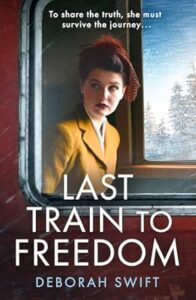
This gripping historical novel invites reading group members into the perilous realm of World War II, where two siblings must flee persecution from Soviet forces in Lithuania. Through thoughtful book club discussions, fellow readers will find themselves caught up in a high-stakes journey aboard the Trans-Siberian Railway, where desperate escapees risk everything in search of freedom. This remarkable book explores profound themes of sacrifice, identity and the indomitable human spirit against a meticulously researched historical backdrop.
BUY THE BOOK FROM HARPER COLLINS and Learn MoreBook Club QuestionsHow does the author use the Trans-Siberian railway journey as both a literal and metaphorical device throughout the novel? What does the train represent?Explore the complex relationship between siblings Zofia and Jacek. How does their bond influence their choices and actions?Several characters in the novel are not what they initially seem. How does the author build suspense around their true identities and motivations?What role does Otto play in the story? How does his character development reflect larger themes about moral choices during wartime?Discuss the significance of documents and paperwork in the novel. How do they represent both hope and danger for the characters?How does the author portray the different faces of resistance and collaboration during this period?What role does identity play in the novel? How do characters hide, change, or maintain their sense of self?Consider the cultural differences portrayed in the novel. How do characters navigate these barriers?How does the author build and maintain tension throughout the railway journey?Discuss the difficult choices characters must make. What would you have done in their situations?How does the novel explore themes of loyalty and betrayal? Which characters stay true to their principles?What role do small acts of kindness play throughout the story? How do they contrast with larger acts of cruelty?Discuss the portrayal of the Jewish refugee experience. How does the author bring this historical reality to life?What does the novel suggest about the nature of survival? What different strategies do characters employ?How does the ending resonate with the themes established throughout the book? What questions remain unresolved?
BUY THE BOOK HERE on Kindle , or read on KindleUnlimited.
The post Book Club Questions for Last Train to Freedom by Deborah Swift #ReadingGroup #BookClub first appeared on Deborah Swift.
Writing The Legend and History of Giulia Tofana by Deborah Swift #GiuliaTofana #HistoricalFiction
When I first had the idea to write about Giulia Tofana, all I knew about her was that she’d killed 600 men in Renaissance Italy. Immediately it made me curious to know why, and what sort of a woman she might be. I wondered whether she was really as murderous as the claims made out, and what I could discover about her by researching her life. I was also attracted to the Italian Renaissance setting and thought it would be fantastic to write a book about her. But if she was such a great subject, why had nobody else done it first?
 A Poison Ring From The Wellcome Trust (wikicommons)Aqua Tofana
A Poison Ring From The Wellcome Trust (wikicommons)Aqua TofanaI soon discovered why. Of the real historical woman there are few traces in any contemporary record and in fact there are more mentions of the poison she invented than the actual person. Many references to her were from the Victorian era, hundreds of years after her death. Rumours abounded about the use of poison rings (see real example of gold hinged snake ring above) and her liquid poison Aqua Tofana.
I also discovered that she was in fact three people, not only one. Her mother and daughter were both often confused with her, and I soon realized I was dealing with three generations of poisoners. That explained all the conflicting dates I was coming across as I delved into the research. The mother, Theofania d’Adamo was executed for her crimes in 1633. The daughter, Girolama Spara, was also executed but sometime later in the 18th Century. So what happened to the middle generation – Giulia Tofana, after whom the famous poison Aqua Tofana is named?
The answer is, nobody knows. So I had a situation a little like writing about King Arthur – we know she existed, but much of her life is rumour or hearsay. What we can be certain of, is that she mattered, because her name has lasted all this time, and her deeds must have had an impact for her notoriety to have spread.
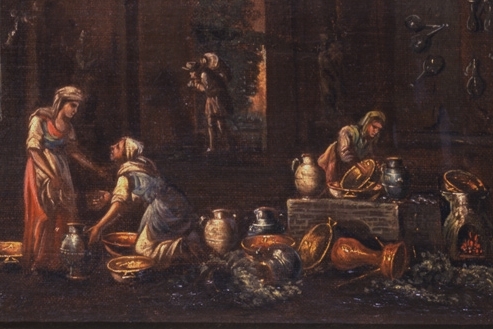
I gradually unpicked the real history, and used much of it in the novel, including her mother’s death. Where no real event existed, I invented or embroidered using research into Italian apothecary practices of the time. What makes the novel historical rather than fantasy is this adherence to known facts and also the attention to detail with the setting and the reality of life in Naples at the time she was alive.
I read through eyewitness accounts of women of the time from letters and diaries. These were hard to find as they had to be in translation, but academic websites such as Academia and JStor supplied me with papers on life in Naples at the time.
Maps were a huge source of interest for me. Giulia and her mother begin life in Palermo, which is now in Sicily, but Giulia has to go on the run to Naples. Most of Italy was under Spanish control at this time. I made use of the old maps which supplied me with the geography and street names, and also places of importance such as churches, markets or the docks.

Because Giulia Tofana is a legend, within the book I needed to show that she mattered and was famous within her own time and that her deeds impacted on the lives around her, especially those of the women. So she had to not only be fascinating to us as readers but also fascinating to people within her own world. This was a challenge, but poison itself is surrounded by plant lore, by ritual, and by mystery, so the subject matter lent itself to a certain amount of myth.
Even today, nobody knows the ingredients of Aqua Tofana, or why it was so deadly. This left me considerable leeway within the book, and I hope I’ve made the most of it.
New Facts about Giulia TofanaSince writing this book in 2021, more evidence about her life has come to light – discovered in the depths of the Vatican library. Some of this evidence conflicts with the previous sources I used for the books. Of course I can do nothing about this. Re-writing the books would be impossible – and besides, there may be more and different evidence yet to be found. What I can do, is incorporate the new evidence into any future books, and continue to take an interest and keep informed about how her life and legend are still subject to development even today.
 Naples 1633
Naples 1633
Aqua Tofana – One drop to heal. Three drops to kill.
Giulia Tofana longs for more responsibility in her mother’s apothecary business, but Mamma has always been secretive and refuses to tell Giulia the hidden keys to her success. When Mamma is arrested for the poisoning of the powerful Duke de Verdi, Giulia is shocked to uncover the darker side of her trade.
Giulia must run for her life, and escapes to Naples, under the shadow of Mount Vesuvius, to the home of her Aunt Isabetta, a famous courtesan. But when Giulia hears that her mother has been executed, and the cruel manner of her death, she swears she will wreak revenge on the Duke de Verdi.
The trouble is, Naples is in the grip of Domenico, the Duke’s brother, who controls the city with the ‘Camorra’, the mafia. Worse, her Aunt Isabetta, under Domenico’s thrall, insists that she should be consort to him – the brother of the man she has vowed to kill.
Based on the legendary life of Italian poisoner Giulia Tofana, this is a story of hidden family secrets, and how even the darkest desires can be vanquished by courage and love.
The post Writing The Legend and History of Giulia Tofana by Deborah Swift #GiuliaTofana #HistoricalFiction first appeared on Deborah Swift.


